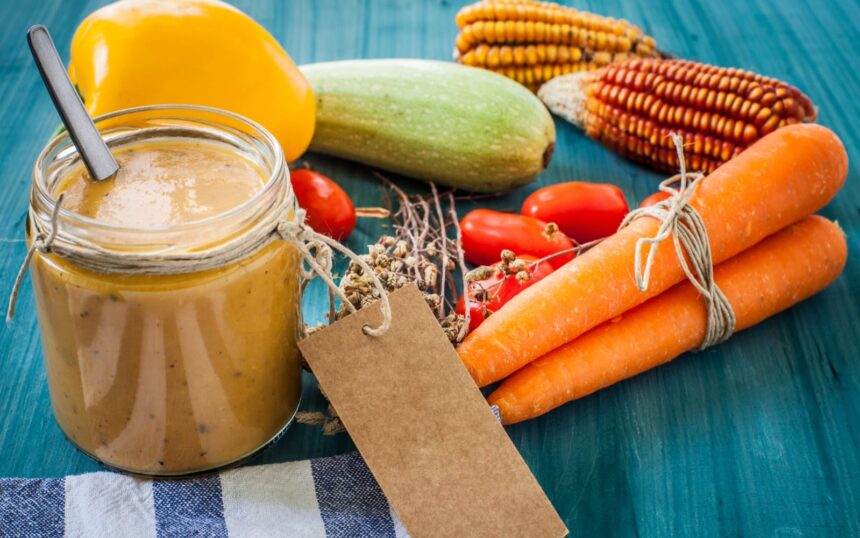Have you heard of sofrito before? Here’s a hint — if you aren’t familiar with the name, you’re almost certainly familiar with its flavor.
Sofrito is an indispensable seasoning used as the base in many Latin Caribbean dishes. Defined as an aromatic mix of herbs and spices, it is used as the secret ingredient to flavor beans, rice, stews, vegetables, meats, and fish in Cuban, Dominican Republican, Mexican, Puerto Rican, and Spanish cuisines. Recently, the word has become more familiar to the American public now that the fast-casual chain, Chipotle Mexican Grill, offers sofritas made out of braised tofu as one of its vegetarian options.
While Sofrito mixtures range in flavor and color depending on specific regions — it may be a vibrant red, deeply rich orange, or green, and can taste either mild or very pungent — it’s a mainstay in Latin Caribbean dishes because it establishes your upcoming meal’s foundation of flavor.
So What is Sofrito, Exactly?

Even though preparation techniques for sofrito will vary depending on regional cuisine, typically sofrito is comprised of aromatic base ingredients that are chopped into very fine pieces, and then braised or sautéed in cooking oil.
Base sofrito seasonings are typically comprised of ingredients like garlic, onions, green, orange, and red bell peppers, tomatoes, annatto seeds (also called achiote seeds), cilantro, Mexican oregano or parsley.
While Cajun cookery uses the merged flavors of the Holy Trinity to serve as the underpinning of the majority of its recipes (much in the same way the French use mirepoix), but what’s unique about sofrito is that it need not only serve as the base of Latin Caribbean recipes — it can also be used almost as a garnish in some Latin American and Spanish dishes!
Regional Sofrito Breakdown
Sofrito is used in a variety of different cuisines to enhance the complexity of flavors in a medley of dishes. Here’s a breakdown of how some traditionally use sofrito.
Spain
In Spain, a sofrito is typically mild and sweet, and made with onions, bell peppers, garlic, and olive oil. You’d see it incorporated into seafood stew. Try this recipe for Jackfruit Ropa Vieja (a Ropa Vieja is a well-known Spanish stew) to see how sofrito seasoning is used in action!
Puerto Rico
 MikeHerna/Shutterstock
MikeHerna/Shutterstock
In Puerto Rico, sofrito traditionally errs toward slightly spicy or pungent flavor profiles, as it is made with cilantro, recao leaves (recao is an herb known as “broad leaf” or “spiny coriander”, and is similar to cilantro), aji dulce (a variety of sweet perennial peppers found in Latin America and the Caribbean), and annatto seeds. Puerto Rican sofrito is traditionally sautéed lightly in either lard or olive oil and then added to a braised protein such as chicken or fish, although it is also added to stewed beans. This article further explains how to use sofrito in delicious Puerto Rican stewed beans.
Cuba
In Cuba, sofrito is made with onions, garlic, and aji dulce, and traditionally features an almost milky flavor. You will find sofritos in a host of different Cuban recipes. They will be used as flavor enhancers in soups and stews, beans, casseroles, and rice-based dishes, as well as sauces for proteins like chicken, pork, and grilled beef. Check out this recipe for Cuban Lentil Soup With Baked Plantains and Lemon Crema for an example of how to use sofrito in plant-based Cuban cuisine.
Yucatan peninsula of Mexico
In the Yucatan peninsula of Mexico, sofritos are often hot and spicy and are made from roasted garlic, cumin, black pepper, and habanero peppers. Check out these gluten-free Spicy Tofu Sofritos to get an idea.
How to Make Your Own Sofrito
 Ramon grosso dolarea/Shutterstock
Ramon grosso dolarea/Shutterstock
Gather the ingredients you’d like to use in your particular blend. If you’re making Puerto Rican sofrito, for example, you’ll want plenty of bell peppers, garlic, yellow onions, cilantro, sweet peppers, and olive oil.and then chop them all up into sizes that are manageable enough to fit inside of either a blender or a food processor. If you don’t have one of those devices, don’t worry — you can just very finely dice and mince all of your ingredients! Just
Next, peel your garlic if necessary, and then chop your ingredients all up into sizes that are manageable enough to fit inside of either a blender or a food processor. If you don’t have one of those devices, don’t worry — you can just very finely dice and mince all of your ingredients! Just make sure to remove the seeds and tough stems from your mix so that your finished sofrito has a nice consistency.
As you’re blending, add a tablespoon at a time of liquid, such as water or a vegetable oil (we suggest olive oil). Your final sofrito blend should have the same consistency as a pesto.
Finally, store your sofrito mix in air-tight glass jars. Sofrito will keep in the refrigerator for about a month, while frozen sofrito will keep in your freezer for two to four months, or longer.
For more great seasoning and flavoring tips, we suggest reading up on How to Braise Your Food for Maximum Flavor as well as learning a little more about umami, and how adding it to your meals will raise their flavor complexity.
Learn How to Cook Plant-Based Meals at Home
Reducing your meat intake and incorporating more plant-based foods into your diet is known to Support various health benefits, including reducing chronic inflammation, improving heart health, enhancing mental well-being, achieving fitness goals, meeting nutritional needs, managing allergies, and promoting gut health, among others. Dairy consumption also has been linked to many health problems, including acne, hormonal imbalance, cancer, prostate cancer, and has many side effects.
For those of you interested in eating more plant-based, we highly recommend grabbing our favorite plant-based cookbooks and downloading the Food Monster App — with over 20,000 delicious recipes, it is the largest plant-based recipe resource to help reduce your environmental footprint, save animals, and get healthy! And, while you are at it, we encourage you to also learn about the environmental and health benefits of a plant-based diet.
Here are some great resources to get you started:
For more Animal, Earth, Life, Vegan Food, Health, and Recipe content published daily, subscribe to the One Green Planet Newsletter! Lastly, being publicly funded gives us a greater chance to continue providing you with high-quality content. Please consider supporting us by donating!



![Pumpkin Spice Biscuits With Feta Cheese [Vegan, Gluten-Free] – One Green Planet](https://top-100-recipes.com/wp-content/uploads/2025/10/pumpk-biscuits-150x150.jpg)

![Pull Apart Christmas Tree [Vegan] – One Green Planet](https://top-100-recipes.com/wp-content/uploads/2025/12/xscreen-shot-2019-11-29-at-1-57-39-pm-150x150.png.pagespeed.ic.9pB2mNa6N_.jpg)



